Quinoa: medicinal properties and contraindications
Swan is an herbaceous annual plant belonging to the Mare family. There are many species of this culture, which take the form of grass, shrubs or semi-shrubs. It is generally believed that it is a completely useless weed crop, so it is destroyed in vegetable gardens or orchards. But in ancient times it was valued among peasants and, as history says, often saved people from starvation. This is due to the fact that the plant was used as a food. It is worth noting that the benefits of quinoa are invaluable, because it contains many valuable components. About this in more detail.
- Chemical composition
- How it looks and where it grows
- Types
- Gathering and storage
- Useful properties of quinoa
- Quinoa herb in folk medicine
- How to prepare an ointment against mastopathy
- Culinary Usage
- Soup
- Cutlets
- Casserole
- Porridge from quinoa seeds
- Cosmetic use
- Can we give rabbits quinoa
- Contraindications to use
Chemical composition
Despite the fact that quinoa is a simple and unpretentious plant, its composition revealed the presence of 17 types of amino acids, which play an invaluable role in the human body. It is also important that the grass contains a large amount, about 30%, of protein compounds - proteins. Therefore, it is believed that the plant in this matter can compete even with meat.
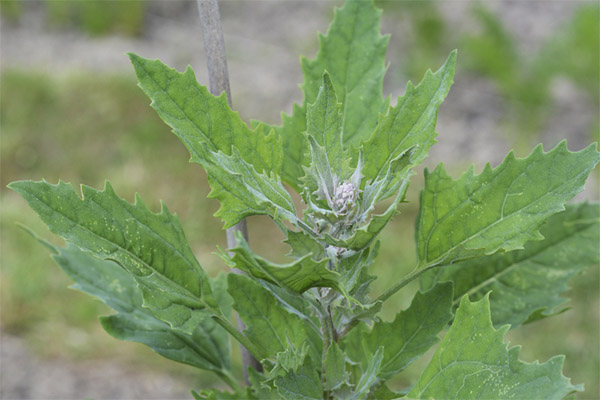
The chemical composition of quinoa is represented by the following components:
- alkaloids;
- about 40% fiber;
- fats;
- carbohydrates;
- oxalic and nicotinic acids;
- B vitamins;
- essential oils in the form of saponin;
- vitamins A, C, E, PP;
- macro- and micronutrients such as manganese, potassium, calcium, sodium, zinc, phosphorus, iron.
The foliage of the plant includes not only as many as 17 kinds of amino acids, but also ascorbic acid and carotene.
How it looks and where it grows
The crop is usually associated with weeds. But this is wrong, because the plant can also be used as a vegetable or medicine, which has absolutely no side effect.
Most often it can be found in vegetable gardens, in fields or wastelands, in ravines, as well as on the banks of water bodies. It is worth noting that this is not only a wild plant, it is often grown as a cultural plant. It is distributed all over the globe. But the largest numbers used for gastronomic purposes are found in Australia and the United States.
Types
Let's take a look at the most well-known species of the crop:
Garden .
An annual plant characterized by an erect stem that has a faceted as well as branched structure. The height can vary from 60 to 180 cm. The foliage varies in shape, but is necessarily elongated, with jagged edges. The taste of the green leaves is sour. The color can be either dark green or red-burgundy. The underside of the foliage has a distinctive milky hue. Flowering is due to the formation of paniculate or spike-like inflorescences colored in a red or green hue. Flowering starts in June or July or August. This species is grown as a vegetable or ornamental plant.
Wild .
This is an annual plant which reaches a height of 30 to 70 cm. The trunk can be upright or stalked. The shoots may be horizontal or directed upward. On long branches, there is a film-like overgrowth. The foliage can have the most diverse shape: triangular, egg-shaped, with the presence of jagged edges. The shade of green is gray-green, which sometimes changes to red. Flowers are collected in peculiar balls, located in the axils of the leaves.
Tatar
An annual plant that can grow as little as 10 cm or reach a height of 1 m. The trunk of the herb is both erect and recumbent. The foliage has an elongated oval tapered shape, distinguished by the presence of jagged edges. The plate is covered with fine villi. The culture blooms from June to October. Flowers are represented by spike-like inflorescences, framed by fine foliage underneath. The plant is used as a food or fodder product.
Heady
An annual that grows to a height of 60 cm. The stem has a stalked shape. The color is green, which changes to red by fall. The foliage is triangular or oval in shape. It sometimes has nicks on it. Flowering lasts from June to August. Flowers are formed into small clusters, colored in a greenish hue.
Lanceolate .
An annual crop that grows to a height of 1 m. The trunk is bare and branched. Leaves are horizontally arranged and uniformly green in color. The shape is triangular-cup-shaped, sometimes jagged. Flowers are clustered in balls, which form spike-like inflorescences.
Sprawling
The grass can range in height from 30 cm to 150 cm. The trunk is erect, branched. The foliage, located in the lower row, is shaped like an irregular rhombus or lance. The leaves are colored with a green hue. The flowers are gathered in spike-like inflorescences of a green hue. The plant is considered not only a forage crop, but also a food crop.
Gathering and storage
In order to harvest quinoa, it is imperative to match the flowering period. It is at this time that the plant contains most of the useful and nutritious components, which are present in the stems, leaves, and inflorescences.
After collecting the plant should be dried in the open air, and then sent for storage in a dry room. The container for storage should be glass. Often, the use of fabric sacks is also allowed for this purpose.
Useful properties of quinoa
It is proved that quinoa improves the digestive processes of the body, supports the health of the kidneys at the appropriate level, and strengthens the cardiovascular system. In addition, it can have the following beneficial effects:
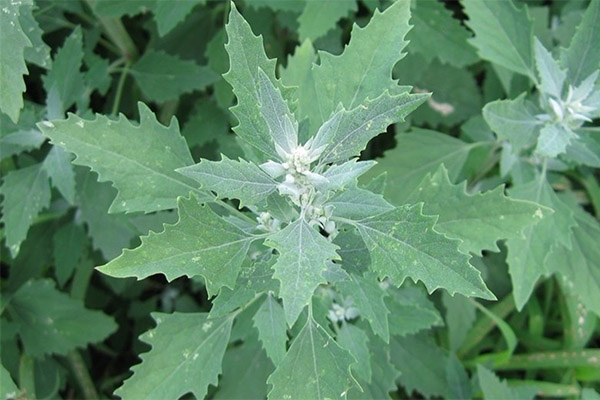
- Strengthening of bones due to the components it contains - magnesium, potassium, phosphorus. In addition, the plant has a high calcium content, which has a beneficial effect on bone tissue, as well as a large concentration of protein, which takes an active part in the process of muscle formation. Regular use of the component helps to avoid the development of such a disease as osteoporosis.
- The heart and blood vessels are also not left out by the beneficial effects of the crop. Thanks to the presence of iron in the composition, the number of red blood cells is maintained at the right level for the body, the level of hemoglobin is normalized. Fiber and potassium can strengthen the heart, as well as remove harmful cholesterol from the blood, and normalize blood flow.
- Thanks to the fact that the plant is a natural source of zinc, iron and copper, improves brain function, as well as the normalization of the nervous system.
- By preparing remedies based on this plant, you can cope with many diseases occurring in the mouth, inflammation of the gums, caused by various factors and the elimination of bad breath. In addition, such remedies are recommended for use in diseases of the upper respiratory tract.
- The crop is considered an excellent diuretic. Its action is to stimulate urination, purify the kidneys and remove salts, toxins and water from the body.
- The antispasmodic properties of the plant are very effective when you need to relieve menstrual pain.
- Because of the antioxidants present in the plant, it slows down the aging process, which leads to the intensive production of natural collagen. Also vitamin C is actively involved in the production of connective tissue and thus prevents the appearance of wrinkles.
In addition to all of the above, thanks to the presence of antioxidants in the composition prevents the onset of cancer, as well as neutralizing free radicals, which provoke the destructive processes in cells.
The herb quinoa in traditional medicine
Quinoa is a herb that has a number of medicinal properties: anti-inflammatory, expectorant, antispasmodic, soothing. Due to the fact that the fresh plant contains a lot of fiber, it acts as a natural sorbent, withdrawing at regular use in its pristine form a large number of slags and toxins, than brings in order the work of the gastrointestinal tract. Tea on the basis of quinoa is recommended for use with severe menstrual pain.
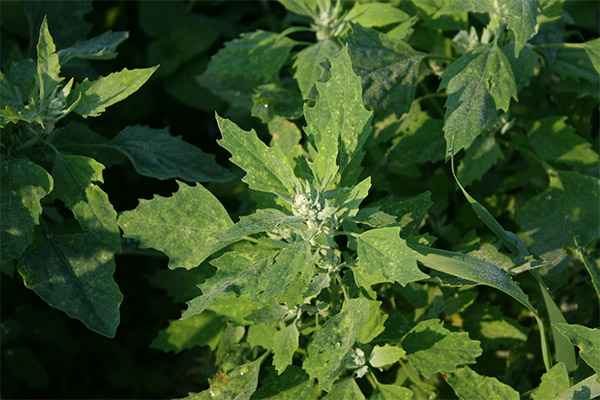
Infusion on the basis of quinoa is used at strains on the nervous system and headaches. In addition, this remedy is effective for gargling of the throat in case of sore throat. Often it is used to prepare lotions for skin diseases of various types.
Preparation of the infusion consists of the following actions:
- Grind dried quinoa and pour into a glass 1 tablespoon.
- Pour 200 ml of boiling water.
- Cover the container with a lid and insist for 2 hours.
- At the end of the given time, strain the composition.
Take the prepared composition should be at least 4 times a day. The amount of the product varies from 1 to 2 tablespoons. It is important to do it 20 minutes before a meal.
Decoction of quinoa is applicable for dry cough or bronchitis. It is important to remember that you should not abuse the remedy if you are prone to constipation, because it also has a hardening effect. The preparation of the decoction consists of the following steps:
- Pour dried and crushed quinoa in a convenient container in an amount of 20 g.
- Pour 200 ml of water brought to the boiling point.
- Send a container with the added contents on the stove and cook for 20 minutes over low heat.
- Remove from the stove and infuse for another half an hour.
- Strain it.
Take the prepared remedy at least 3 times a day after a meal. The number of single reception will be ½ cup.
To prepare a decoction based on the seeds of quinoa spreading will require the following actions:
- Dry seeds in the amount of 1 tablespoon pour 300 ml of water brought to boiling temperature.
- Wait until the mass cools, and strain.
Treatment with a prepared means is the daily intake of three times 2 tablespoons decoction. The course lasts for 1 week.
To prepare an alcoholic tincture on the basis of quinoa, it is necessary to perform a series of the following actions:
- Grinded grass in an amount of 2 tablespoons pour 200 ml of alcohol or vodka.
- The composition should be kept in a dark place for 2 weeks.
- From time to time, be sure to shake the composition.
- At the end of a given time, strain.
Take the prepared medicine daily by 1 teaspoon.
The juice of quinoa is effective for both external and internal use. First of all, it should be used for disinfecting and healing wounds. In order to prepare it, you need to prepare fresh leaves of quinoa and pass it through a meat grinder. Put the resulting puree in gauze or another piece of suitable clean cloth and squeeze well. The juice is ready. Soak a gauze bandage and apply to the affected area of the skin. Also such a remedy is effective for various skin diseases.
For internal reception, you need to fill a glass half full with juice, add 1 teaspoon of honey and drink daily. This is a very useful drink that strengthens the immune system.
Decoction based on quinoa can be used to treat thrush. Preparation of a remedy for douches is as follows:
- Crushed herbs in an amount of 4 tablespoons put in a container and pour 200 ml of water brought to a boiling temperature.
- Send a container to the stove and boil the composition on the fire of minimum intensity for 15 minutes.
- Remove from the stove, cool and squeeze the raw material, then strain the liquid and dilute it with 1 liter of boiled water.
Use the resulting composition for douches with thrush. But the resulting remedy can also be taken internally. When gout is exacerbated - it is an indispensable remedy, which should be used from 2 to 4 times a day for ½ cup.
To treat dry coughs, brew 1 teaspoon of crushed quinoa in 200 ml of water brought to a boiling temperature. Infuse for half an hour, and then strain. Add 1 teaspoon of honey before using. Drink the drink three times a day. The action of the remedy is that quinoa affects the phlegm and liquefies it, and the honey promotes excretion.
For sciatica, it is recommended to use fresh leaves of the culture, which should be steamed and then applied to the sore spot. Then wrap the painful area together with the herb in a warm cloth and leave it for the night. Such a compress will relieve the inflammatory process and alleviate painful sensations.
A course of treatment for various cardiovascular diseases is also recommended to be supplemented with quinoa. You can take the plant fresh as a product or prepare a decoction:
- Bring 300 ml of water to boiling temperature, and then brew in it 2 tablespoons of crushed quinoa.
- Insist the composition under a closed lid for half an hour.
- Strain.
- Divide the resulting liquid into 3 doses.
The course of treatment will be at least 14 days.
How to prepare an ointment against mastopathy
This method of treatment is often used in folk medicine, but if in doubt, you should consult your doctor about the use of this remedy.
Step-by-step preparation of the ointment:
- Collect the green mass of the plant, which can include leaves, stems and inflorescences, weighing 1 kg.
- Wash thoroughly under cold running water, and then spread out on a linen towel for drying.
- Salted pork fat in the amount of 500 g peel, cut into small pieces and turn into mush with a meat grinder.
- Swan, which is already completely dried, also grind it with a meat grinder.
- Thoroughly mix the resulting mass and send it for storage in a refrigerator.
Do not smear the ointment on the body. The application requires the following recommendations:
- Take a clean sheet of paper and apply an even layer of the prepared ointment.
- Put the treated paper on the breast area.
- Press the compress to your chest with a warm scarf or woolen handkerchief.
- Try to hold the compress until the fat is completely absorbed into the skin.
Immediately after removing the compress you should wash your body with soap and water.
It is recommended to continue the treatment until all the hard spots disappear. On no account should you use polyethylene for the procedure.
Cooking Uses
The taste qualities of quinoa are peculiar. Boiled seeds taste similar to buckwheat porridge. The leaves, on the other hand, do not have a pronounced taste as well as an aroma. This is an advantage of this crop. When added to various dishes, the ingredient almost does not change their taste, but greatly increases the nutritional value.
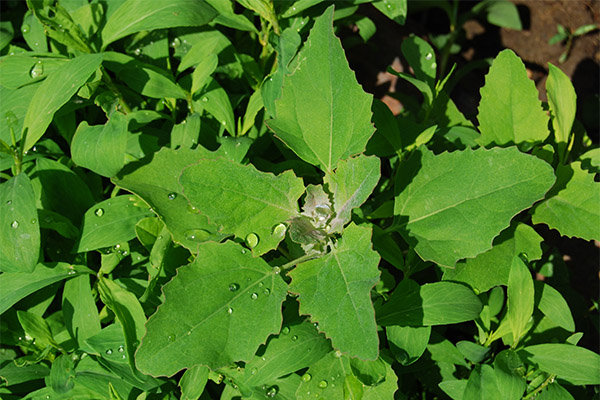
But the quinoa perfectly absorbs other flavors and aromas, like some types of mushrooms. Therefore, in cooking, the product is used with many spices and seasonings. Parsley, garlic, onion, bay leaf can be used to give a nice flavor to the swan.
In cooking, not only the green mass of the plant is used, but also the seeds. Quinoa is added to various salads, soups, stewed like cabbage, fried in a pan with the addition of vegetable oil, used to decorate dishes for the festive table. The seeds are used to make porridge just like any other cereals, they are also ground and mixed with flour for further use in baking bread and pancakes.
It should be noted that quinoa can be combined with almost any other foodstuff.
Soup
Soup, cooked on the basis of quinoa, turns out very fragrant, tasty and useful. To prepare it, you need to perform the following actions:
- In a saucepan pour 300 ml of purified water, send on the stove and bring to boiling temperature.
- Cut into small cubes 3 mushrooms of any kind and send them to a saucepan with boiling water.
- 2 medium-sized potato tubers should be peeled, washed, cut into small cubes and sent to the pot.
- Carrots of medium size peeled, washed, cut into small cubes and pour into the boiling water.
- Wash 100 g of young leaves of quinoa, 40 g of sorrel, 20 g of green onions and finely chop them.
- Once the potatoes in the pot has reached readiness, send there the prepared greens.
- Boil the soup for a few more minutes.
- Add to it also the necessary spices, such as cilantro, oregano, coriander, basil, fresh dill.
Just before serving, dress the soup with sour cream. It is recommended to serve the dish in tandem with mustard.
Cutlets
This dish is ideal for fasting people, or fans of vegetarian cuisine. To prepare the cutlets, you need:
- Wash the leaves of quinoa in the amount of 150 g, and then finely chop them.
- Put them in a pot, pour salted to taste water, add 30 g of oatmeal, put on the stove and cook until it is ready porridge.
- Remove from the stove and leave until it cools.
- Form the cutlets from the porridge, roll them in breadcrumbs and fry in vegetable oil until brown on both sides.
Such cutlets can be not only fried, but also cooked on steam.
Casserole
To prepare an unusual and delicious casserole, you will need to perform a number of the following steps:
- Wash 700 g of garden quinoa thoroughly, and then boil it in salted to taste water for 10 minutes.
- Rinse it in a colander and give time for the excess moisture to escape and cool. Then chop the boiled herbs with a knife.
- Boil 50 g noodles in salted water to taste, without waiting for them to boil. Drain it and rinse under cold running water.
- Melt 75 g butter in a separate bowl. Add 125 g of wheat flour to it. Fry briefly, then add the noodles and shredded boiled quinoa. Braise on a low heat for 5 minutes.
- Remove from the heat and slowly add 300 ml of warm milk, remembering to stir at the same time.
- Add 2 eggs and 50g of ham cut into julienne strips.
- Add salt and pepper to taste.
- Butter a tray of suitable size, sprinkle with breadcrumbs and put the mixture on it. Grate 50g of brynza cheese on top.
- Bake for 40 to 50 minutes. The dish will be ready as soon as the appetizing ruddy crust appears.
Porridge from quinoa seeds
Step-by-step preparation of porridge:
- A pan with a thick bottom grease with vegetable oil, heat on the stove.
- Dice 300g of pork and place it in the pan. Fry until crispy, then season with salt and pepper.
- Peel 2 heads of onion, then cut into cubes and send to the meat in the pan. Braise for a few minutes.
- Now peel 2 medium-sized carrots, wash, also cut into cubes and pour into the pot. Braise the composition for a few more minutes.
- Remove the skin from a zucchini of medium size, cut it into cubes and send it also to the container. Immediately add 50 grams of fresh green peas.
- Mix these and add dried parsley and dill.
- Add 100g of quinoa seeds and pour water so that it only covers the ingredients in the pot. Boil until soft.
Use in cosmetics
Quinoa can also be used in cosmetology. It is known to have a powerful rejuvenating effect on the skin. This herb is used to make effective masks of moisturizing and nourishing effect, which tones the skin and increases its elasticity.
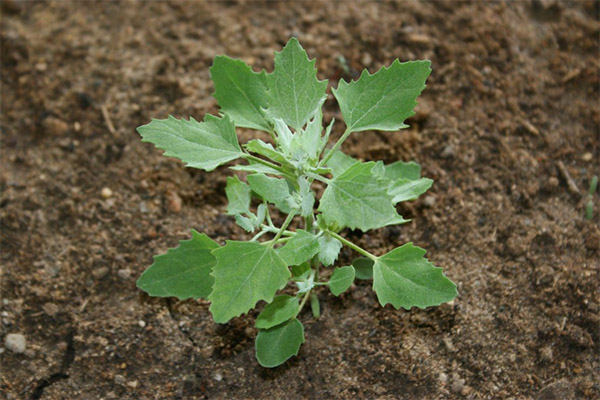
Infusion of this herb is often used for washing. It is recommended twice a day to wash your face, and the skin in a month will shine with youth and beauty. To prepare this remedy is very simple: pour the available amount of herb in boiling water, wrap the container in a warm blanket and insist the composition for 1 ½ hours. After that, you can immediately use the product.
Preparation of the most popular mask on the basis of quinoa, which is often called "the Slavic secret of youth", consists of the following actions:
- Pour 100 ml of water, brought to boiling temperature, 1 teaspoon of crushed dried quinoa.
- Leave to infuse for half an hour.
- Strain through a sieve and add milk to the composition, based on the proportion of 1:1.
- Soak tissues in the prepared composition and put on the previously cleansed skin of the face.
- Leave for 20 minutes. During this time it is worth to put off all business and lie down.
To make such a mask more dry, sour cream or yogurt is often added instead of milk.
Judging by reviews, a remedy from the seeds of quinoa prevents the aging of the skin. It can be prepared as follows:
- Boil 2 tablespoons of quinoa seeds in soy milk. Leave it to cool down completely.
- In a convenient container, combine 2 egg yolks, 3 teaspoons of natural yogurt and 2 drops of mimosa essential oil with the boiled seeds.
- Beat the composition, using a blender.
The resulting mask is applied in an even layer to the skin of the face and neck. Exposure time - 20 minutes. Then wash off with warm water.
Nourishing facial remedy:
- In a common container, combine 1 teaspoon of broth based on quinoa with 1 teaspoon of freshly squeezed carrot juice.
- Add 1 teaspoon of honey. Mix until a homogeneous mixture is obtained.
Apply the composition to the face with a special brush. Wash it off with weakly brewed black tea, pre-cooled. If you use this cosmetic two times a week, the skin will get a light tan effect.
Not bad proved itself and moisturizing mask for the face. Her recipe:
- Grate a fresh cucumber on a grater.
- In a separate container to put 2 tablespoons of crushed vegetables and add to it 1 tablespoon of broth based on quinoa.
- Add ½ tablespoon of olive oil and mix thoroughly.
The resulting mask applied to the face and leave for 10 minutes. Prepare a weak green tea brew or parsley-based decoction to wash off the mask. After 5 minutes after that, wipe the face with an ice cube or gently wash with cool water.
Benefits for the hair
The herb contains many components, which have a beneficial effect on the hair. Thanks to the proteins of plant origin contained in the composition cleanses and nourishes the curls. Amino acids protect and strengthen the roots, provide the necessary nutrition for the hair follicles.
Due to the fact that the culture contains iron, phosphorus and potassium, the proper amount of moisture for the scalp is provided. Therefore disappears dry skin in this area and peeling.
Thanks to vitamin E, whose action is to supply natural oils, the hair is kept naturally moisturized, which prevents brittleness and tangles.
To prepare a mask that strengthens the structure of the hair, you need:
- Grind 2 tablespoons of dried quinoa.
- Pour the herb in a convenient container 200 ml of water, brought to boiling temperature.
- Insist the composition for 30 minutes. Then strain.
- Add 1 tablespoon of burdock or castor oil.
- Mix until homogeneous.
Rub the ready mask into the root of the hair and leave it for half an hour. After a specified time, wash your hair with shampoo.
Can rabbits be given quinoa
For rabbits, quinoa is not the most tasty treat, because, according to experienced farmers, they eat it reluctantly. But this does not mean that the grass is not useful. As mentioned earlier, the culture contains a large number of useful components, which will also have a positive effect for rodents, strengthen immunity. With moderate use, the product will improve the digestive system of rabbits. The intake of the product for animals is allowed in small quantities and not daily, but only a few times a week.
How to feed the rodents correctly with quinoa
To feed rabbits, it is recommended to use only young leaves of quinoa. This is due to the fact that they contain the greatest number of useful components. Also for the collection you can choose the time when the process of flowering of the plant begins. It is also recommended to supplement the ration with other herbs, such as burdock, dandelion, nettle, plantain.
Swan for rabbits can be given both fresh and dried. Any case requires introducing a small amount of the new product into the diet at first. Only then should you gradually increase the portion and observe the reaction of the animal.
Contraindications to use
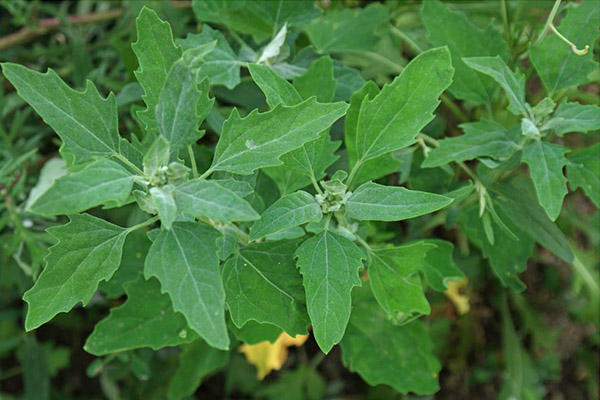
In rare cases, the swede can cause harm to the body. But still there are some diseases in which the consumption of the plant is strictly prohibited:
- Individual intolerance of individual components of the product;
- Low blood clotting index;
- certain gastrointestinal diseases, such as colitis, ulcers, gastritis;
- urolithiasis;
- A tendency to bleeding.
There is also the possibility of an overdose, which can lead to diarrhea, vomiting, and digestive system disorders. This can be the trigger for the formation of ulcers. So, the consumption of quinoa should be approached with extreme caution.
Quinoa is a herb that has a lot of positive properties, which it owes to the presence of a large number of useful substances in its composition. The culture is actively used in cooking for the preparation of many delicious, nutritious and healthy dishes, in folk medicine for the treatment and prevention of many diseases. In cosmetology, there are also many means that are prepared using this culture.
«Important: All information on this site is provided solely for introductory purposes. Consult with your health care professional before applying any recommendations. specialist before using the recommendations. Neither the editors nor the authors shall be liable for any possible harm caused by materials."















